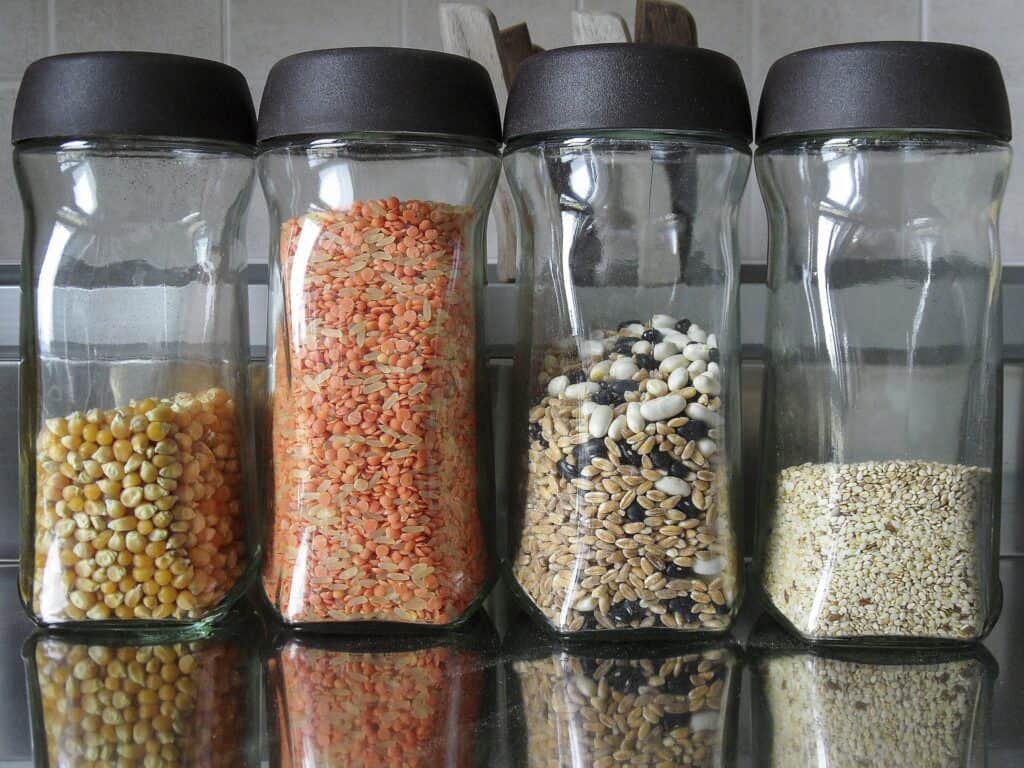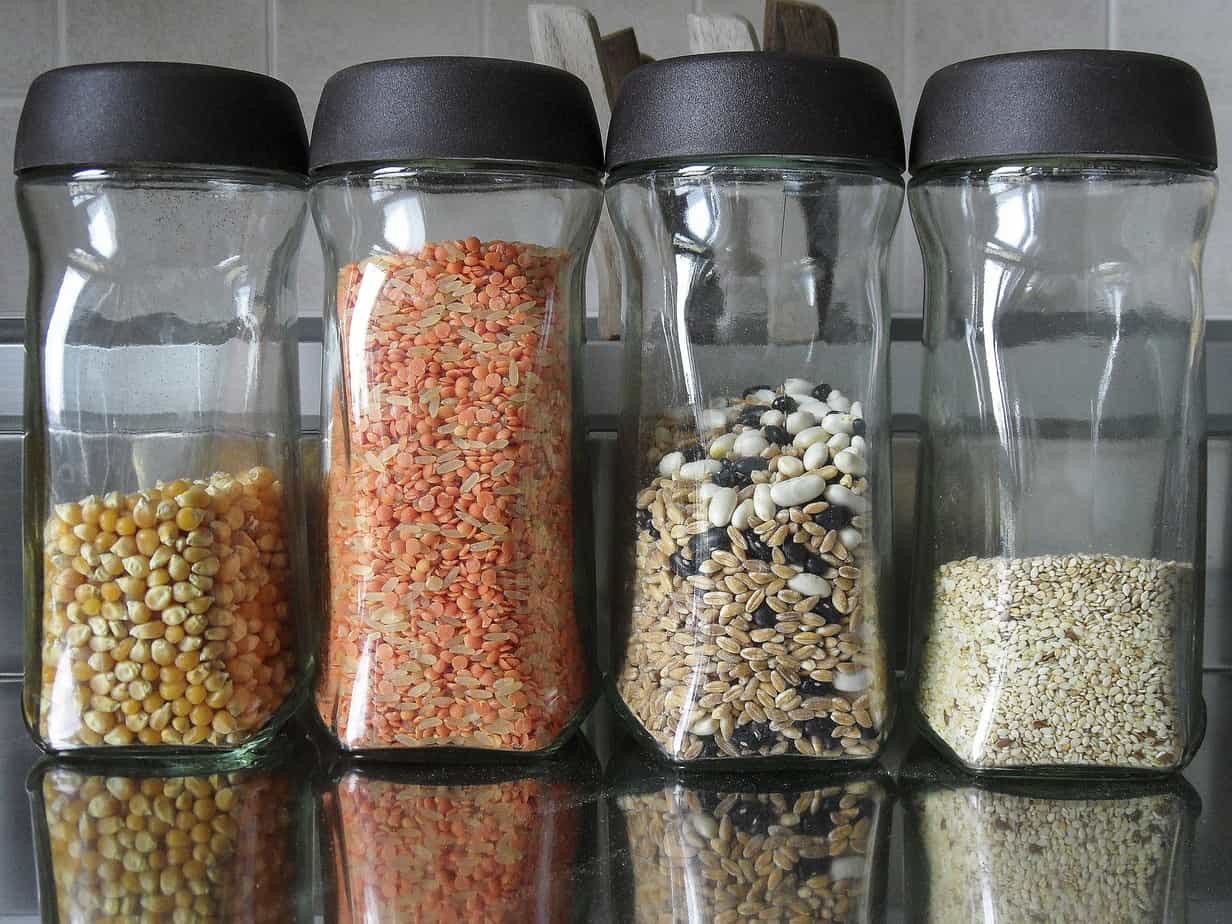When you’re looking to drastically cut your expenses, having a 100 dollars a month grocery list can make a huge difference. Food costs can add up quickly if you aren’t watching them!

$100 a month comes out to $25 a week or about $3.50 a day for a typical month. That might sound tricky, but it’s totally doable to make that stretch for multiple meals a day if you avoid high-cost ingredients.
Let’s look at an example 100 dollars a month grocery list and some general principles for cheap grocery shopping and cooking!
Ibotta is my favorite cash back grocery app. With Ibotta, you can earn real cash back every time you shop online or in-store. Download the app, choose and unlock rebates you want at various stores. After purchase, scan or photograph your receipt within the app. When your receipt is approved, the cash will be added to your account.
100 Dollars a Month Grocery List
Exact prices in your area may differ, but you can actually get quite a lot of food on a 100 dollars a month grocery list! Let’s check out the list based on average prices.
Brown rice (5lbs for $3.50): Rice is an amazing staple food, since it costs almost nothing! Brown rice is much more nutritious than its white counterpart. Use it for burrito bowls, stir-fries, and other rice dishes.
Beans (4lbs for around $5, dried): Cook up black beans to add to those burrito bowls, red beans for jambalaya, white beans for a soup, etc. Beans are versatile ingredients with plenty of protein and fiber.
Chickpeas (2lbs for $2.50, dried): Make your own hummus, falafels, Buddha bowls, and roasted chickpea snacks.
Lentils (3lbs for $4, dried): Lentils are a great unassuming superfood full of protein and fiber. Use it for lentil soup, veggie + lentil shepherd’s pie, Indian-style dal, etc.
Potatoes (10lbs for $5): Boil em, mash em, stick em in a stew…
Oats (3lbs for $4): If you make your own oatmeal instead of buying instant packets, you’ll enjoy better nutritional value and more bang for your buck. Top with fruits, seeds, peanut butter, or whatever you have on hand. To be super frugal, you can also use these to make your own oat milk!
Flaxseed (16oz for $2.50): Add to your oatmeal, anything you bake, and even smoothies for extra fiber and omega 3 healthy fats.
All-purpose flour (5lbs for $2.50): Flour is so cheap and versatile. Just teach yourself a few basic recipes like pancakes, quick breads, and tortillas, and you’ll have a great start to a lot of different meals. You can even use flour to make a high-protein “wheat meat” version of chicken.
Tofu (14oz for $1.50, 4 blocks for $6): If you have an Asian grocery store nearby, you can get all kinds of tofu very cheaply. It’s much easier on the budget than meat for a 100 dollars a month grocery list, and healthier than most meats too. Check out some easy tofu recipes here.
Whole wheat sandwich bread (2 loaves at $1/loaf, $2): Sandwiches and toast!
Peanut butter (40oz for $2.75): Perfect for oatmeal, peanut butter and jelly sandwiches, pancakes, or by the spoon!
Jam ($2): Pick your favorite flavor in a store brand.
Cereal or granola ($3): Buy a box or bag of a healthy cereal to alternate for breakfasts.
Your milk of choice ($2.50): Personally I go for oat, almond, or soy milk.
Pasta (5 16oz boxes at $1 per box, $5): If you make half a box at a time, you can have ten pasta meals a month on your $100 grocery budget!
Canned tomato sauce (5 8oz cans for $.50 each, $2.50): If you buy basic tomato sauce in a can, you can add your own spices like garlic, salt, and herbs to jazz up the flavor without paying for a fancy jarred sauce.
Veggie burgers ($3.50): A 4-pack of most veggie burgers will be around this price range; you can eat them on a bun or chop them up for a salad topping.
Frozen vegetables (10 12oz bags at $1 per bag, $10): Skip the “steam-in-bag” frozen veggies, which usually have a convenience price markup, and opt for store-brand veggies like peas, broccoli, cauliflower, corn, brussels sprouts, kale, etc. Toss into various recipes you make. Frozen veggies are more nutritious than canned!
Fresh vegetables (budget another $10): With some veggies, you can’t beat fresh. You can still get a decent amount with a small budget, like a 3lb bag of onions for $2.50, 2lbs of carrots for $2, a head of lettuce for $1.50, mushrooms for $1.50, garlic bulbs for 50 cents each, etc.
Frozen fruits (4 bags at $2 per bag, $8): Get a few different kinds of frozen fruits like strawberries, blueberries, mangoes, and pineapple that you can use to make smoothies, add to oatmeal, etc. Fruits aren’t as important as veggies, but they are packed with important vitamins and antioxidants so it’s worth including them in your $100 a month grocery list even if they do cost a bit more.
Fresh fruits ($8): Bananas are about 50 cents per pound and some types of apples are $1/pound. These are fruits that it’s better to buy fresh, and you can snack on them as-is or add them to other meals.
$10 free budget: Everything on the list so far only adds up to around $90, so fill in the rest of your 100 dollars a month grocery list with anything you want to fill in the gaps!
You’ll notice that the list doesn’t include things like basic pantry ingredients or spices, since those are all things that should ideally last you more than a month.
Here are some pantry items it’s good to keep in stock:
- Baking soda
- Baking powder
- Yeast
- Salt
- Garlic powder
- Onion powder
- Italian seasoning
- Any other spices you use
- Soy sauce
- Cooking oil
Asian grocery stores are a good place to cheaply stock up on spices.
Tips to Save Money on Groceries
Let’s look at a few more tips to keep your grocery budget as cheap as possible!
- Use cash-back apps. Download Ibotta here, Dosh here, Drop here, and Checkout 51 here to save on groceries.
- Buy store brands. Often it’s the same thing, without paying extra for a brand name.
- Convenience is the enemy. Usually, the easier a food is to make (e.g. microwave), the more it costs per pound and the less healthy it is. Buy original whole foods as much as possible.
- Learn where your local cheap stores are. It could be an international market, a discount grocery store, or an ALDI. Explore and compare.
- Stock up during sales. As long as you have the space to store extra food, take advantage of good discounts!
Ready to head to the store with your 100 dollars a month grocery list in hand? Next, check out these dirt-cheap meal ideas to get you started brainstorming recipes.

Kate is a writer and editor who runs her content and editorial businesses remotely while globetrotting as a digital nomad. So far, her laptop has accompanied her to New Zealand, Asia, and around the U.S. (mostly thanks to credit card points). Years of research and ghostwriting on personal finance led her to the FI community and co-founding DollarSanity. In addition to traveling and outdoor adventure, Kate is passionate about financial literacy, compound interest, and pristine grammar.




